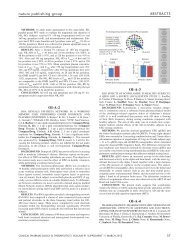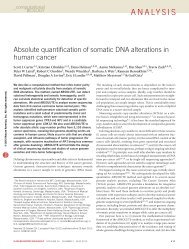open access: Nature Reviews: Key Advances in Medicine
open access: Nature Reviews: Key Advances in Medicine
open access: Nature Reviews: Key Advances in Medicine
You also want an ePaper? Increase the reach of your titles
YUMPU automatically turns print PDFs into web optimized ePapers that Google loves.
STROKE IN 2011<br />
Major advances across the spectrum<br />
of stroke care<br />
Lee H. Schwamm<br />
NEUROLOGY<br />
Several pivotal cl<strong>in</strong>ical trials that could have a major impact on the care of patients with stroke were published<br />
<strong>in</strong> 2011. The studies cover a wide range of stroke-care aspects, <strong>in</strong>clud<strong>in</strong>g stroke prevention, imag<strong>in</strong>g to select<br />
patients for thrombolysis, therapies for stroke recovery, and stroke registries to improve care quality.<br />
Schwamm, L. H. Nat. Rev. Neurol. 8, 63–64 (2012); published onl<strong>in</strong>e 10 January 2012; doi:10.1038/nrneurol.2011.225<br />
The current framework for analyz<strong>in</strong>g the<br />
complete spectrum of stroke care is conceptualized<br />
<strong>in</strong> the ‘stroke systems of care’ model 1<br />
(Figure 1), as del<strong>in</strong>eated <strong>in</strong> a policy statement<br />
of the American Stroke Association <strong>in</strong><br />
2005. The model specifies seven doma<strong>in</strong>s of<br />
care—primary prevention; community education;<br />
notification and response of emergency<br />
medical services; acute stroke treatment; subacute<br />
stroke treatment and secon dary prevention;<br />
rehabili tation; and con t<strong>in</strong>uous quality<br />
improvement activities—and emphasizes the<br />
l<strong>in</strong>ks between them. In 2011, five doma<strong>in</strong>s of<br />
the stroke systems of care model have witnessed<br />
major breakthroughs that have the<br />
potential to dramati cally <strong>in</strong>fluence the delivery<br />
of stroke care now and <strong>in</strong> the future, thereby<br />
further erod<strong>in</strong>g the therapeutic nihilism that<br />
still surrounds much of stroke treatment.<br />
Nonvalvular atrial fibrillation is a major<br />
preventable cause of first ever and recurrent<br />
stroke. Warfar<strong>in</strong> has been the ma<strong>in</strong>stay of<br />
therapy for almost half a century, but it has<br />
a narrow therapeutic range that is difficult to<br />
ma<strong>in</strong>ta<strong>in</strong> <strong>in</strong> many patients, requires frequent<br />
monitor<strong>in</strong>g, and is highly susceptible to drug<br />
and food <strong>in</strong>teractions. The ARISTOTLE trial 2<br />
compared the oral direct factor Xa <strong>in</strong>hibitor<br />
apixaban with warfar<strong>in</strong> for efficacy <strong>in</strong> stroke<br />
prevention <strong>in</strong> over 1,800 patients with atrial<br />
fibrillation and an elevated stroke risk score.<br />
In both groups, just under 15% of patients<br />
had a prior myocardial <strong>in</strong>farction, and 20%<br />
had a prior stroke, transient ischemic attack<br />
or systemic embolism. The results showed<br />
that apixaban is superior to warfar<strong>in</strong> <strong>in</strong><br />
reduc<strong>in</strong>g the risk of stroke or systemic embolism<br />
(<strong>in</strong>cidence rates 1.27% versus 1.60% per<br />
year; HR 0.79; P








